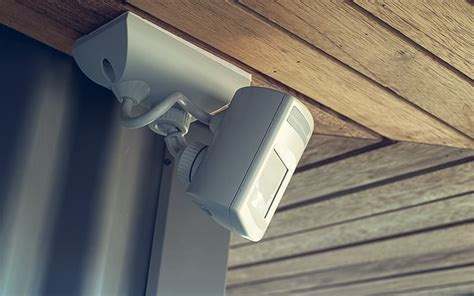Diving into the realm of Exterior Motion Detection Systems & Home Insurance, this introduction sets the stage for an insightful exploration of how these systems impact home security and insurance premiums. The blend of technology and protection offers a fascinating look into safeguarding your home.

As we delve deeper, we uncover the intricate relationship between exterior motion detection systems and home insurance, shedding light on the innovative ways they work together to keep your home safe and secure.
Overview of Exterior Motion Detection Systems
Exterior motion detection systems are security devices designed to detect movement outside of a property. These systems are typically installed near entry points, driveways, or outdoor spaces to monitor and alert homeowners of any suspicious activity.
How Exterior Motion Detection Systems Work
Exterior motion detection systems work by using sensors to detect changes in infrared energy levels caused by moving objects. When motion is detected, the system triggers an alarm or sends a notification to the homeowner's smartphone or security system.
Benefits of Using Exterior Motion Detection Systems
- Enhanced Security: Exterior motion detection systems provide an added layer of security by alerting homeowners of potential intruders or suspicious activity.
- Peace of Mind: Knowing that your property is being monitored can give homeowners peace of mind, especially when they are away from home.
- Deterrence: The presence of exterior motion detection systems can deter potential intruders from attempting to break into a property.
Types of Exterior Motion Detection Systems
- Passive Infrared (PIR) Sensors: These sensors detect changes in heat energy and are commonly used in motion-activated lights.
- Microwave Sensors: These sensors emit microwaves and detect changes in frequency when objects move within the detection range.
- Ultrasonic Sensors: These sensors emit high-frequency sound waves and detect changes in the pattern when objects move.
Importance of Exterior Motion Detection Systems for Home Insurance
Exterior motion detection systems play a crucial role in influencing home insurance premiums and overall security measures for homeowners. By having these systems in place, homeowners can significantly reduce the risks associated with potential burglaries and vandalism, leading to fewer insurance claims and a safer living environment.
Impact on Home Insurance Premiums
Exterior motion detection systems can have a positive impact on home insurance premiums by signaling to insurance providers that the property is equipped with advanced security measures. This can result in lower premiums as the risk of theft and damage is reduced with the presence of these systems.
Enhanced Home Security and Reduced Insurance Risks
Installing an exterior motion detection system enhances home security by providing real-time alerts and deterring potential intruders. This added layer of protection not only gives homeowners peace of mind but also reduces the likelihood of insurance claims related to theft or property damage.
Preventing Potential Burglaries and Vandalism
Exterior motion detection systems act as a proactive measure in preventing potential burglaries and vandalism. The ability to detect movement around the property and trigger alarms or notifications can deter criminals from targeting the home, ultimately leading to a decrease in insurance claims and a safer living environment for residents.
Features to Consider in Exterior Motion Detection Systems
When choosing an exterior motion detection system for your home, it is essential to consider key features that will enhance your security measures and provide peace of mind. Whether you opt for a wired or wireless system, each has its own set of pros and cons that can impact your decision.
Additionally, integrating these systems with smart home technology can offer added convenience and efficiency in monitoring your property.
Key Features to Look For
- Range and Detection Area: Ensure the system covers the desired area around your home and has a sufficient range to detect motion accurately.
- Sensitivity and Adjustability: Look for systems that allow you to customize the sensitivity levels to avoid false alarms while still detecting potential threats.
- Weather Resistance: Opt for systems that are weatherproof to withstand outdoor elements and ensure continuous functionality in all conditions.
- Integration with Security Cameras: Consider systems that can be integrated with security cameras for visual verification of detected motion.
- Remote Access and Alerts: Choose systems that offer remote access through mobile apps and send alerts in real-time to your smartphone or other devices.
Wired vs. Wireless Systems
When deciding between wired and wireless exterior motion detection systems, it's important to weigh the pros and cons of each:
| Wired Systems |
Wireless Systems |
| Reliability and consistent power supply
. |
Easy installation without the need for wiring. |
| Less susceptible to interference. |
Flexible placement and relocation of sensors. |
| More challenging installation process. |
Dependent on battery life and signal strength. |
Integration with Smart Home Technology
Integrating exterior motion detection systems with smart home technology can offer advanced security features and seamless monitoring:
- Control and monitor your system remotely through smart devices.
- Automate lighting and other security measures based on detected motion.
- Receive notifications and alerts through smart home hubs or voice assistants.
- Integrate with other smart devices for a comprehensive home security system.
Installation and Maintenance of Exterior Motion Detection Systems
Installing and maintaining exterior motion detection systems is crucial to ensure the security of your home. Proper installation and regular maintenance can help these systems function effectively in detecting any movement around your property. Here is a step-by-step guide on how to install and maintain your exterior motion detection system:
Installation of Exterior Motion Detection Systems
- Choose the right location: Select strategic spots around your home where the motion detectors can cover a wide area without obstructions.
- Mount the sensors: Install the motion sensors at a height of 6-8 feet above the ground level to avoid false alarms caused by pets or small animals.
- Connect the system: Follow the manufacturer's instructions to connect the motion sensors to the control panel and power source.
- Test the system: After installation, test the system to ensure that the motion detectors are working correctly and detecting movements accurately.
Maintenance and Troubleshooting
- Regularly clean the sensors: Dust, dirt, and debris can accumulate on the sensors, affecting their performance. Clean them periodically to ensure optimal function.
- Check the power source: Make sure that the power source is uninterrupted and the batteries are replaced as needed to prevent system failure.
- Inspect for damages: Regularly inspect the sensors, wiring, and control panel for any damages or signs of wear and tear. Replace any faulty components immediately.
- Adjust sensor settings: If you experience false alarms or missed detections, consider adjusting the sensitivity and range of the motion sensors to optimize performance.
Importance of Regular Maintenance
Regular maintenance of your exterior motion detection system is essential to ensure its long-term effectiveness. By keeping the system well-maintained, you can prevent false alarms, improve detection accuracy, and enhance the overall security of your home. Neglecting maintenance can lead to system malfunctions, leaving your property vulnerable to security threats.
Closing Summary
In conclusion, Exterior Motion Detection Systems not only provide an added layer of security to your home but also play a significant role in potentially lowering your insurance premiums. By investing in these systems, you are taking proactive steps towards safeguarding your property and loved ones.
FAQ Corner
Do exterior motion detection systems reduce home insurance premiums?
Yes, having an exterior motion detection system can often lead to reduced insurance premiums due to the increased security it provides. Insurers see it as a proactive measure against potential risks.
What are the key features to look for when choosing an exterior motion detection system?
Key features to consider include range, sensitivity, weather resistance, and integration capabilities with other smart home devices. These aspects ensure optimal performance and seamless operation.
How do wired and wireless exterior motion detection systems differ?
Wired systems require physical connections for power and data transmission, offering reliability but requiring more installation effort. Wireless systems, on the other hand, are easier to install but may be susceptible to signal interference.
Is regular maintenance necessary for exterior motion detection systems?
Yes, regular maintenance is crucial to ensure the system functions effectively over time. This includes checking for any obstructions, adjusting sensitivity settings, and replacing batteries when needed.
 As we delve deeper, we uncover the intricate relationship between exterior motion detection systems and home insurance, shedding light on the innovative ways they work together to keep your home safe and secure.
As we delve deeper, we uncover the intricate relationship between exterior motion detection systems and home insurance, shedding light on the innovative ways they work together to keep your home safe and secure.









